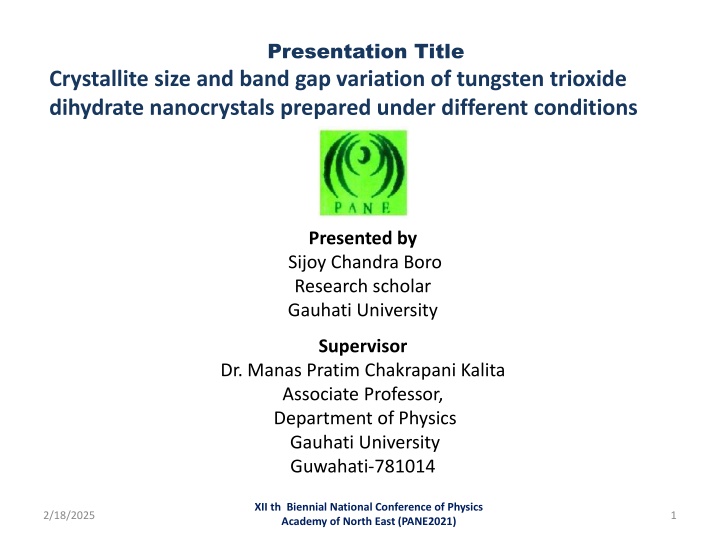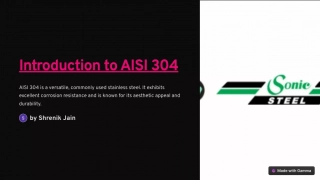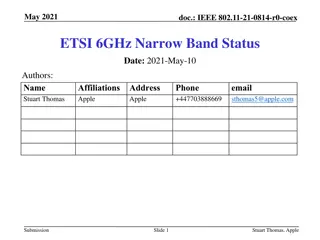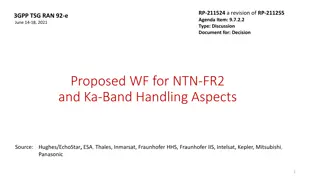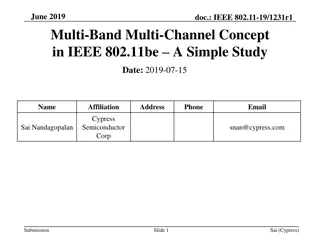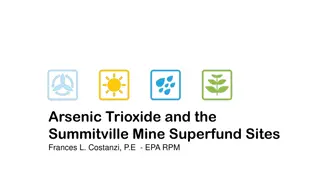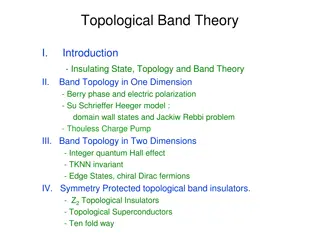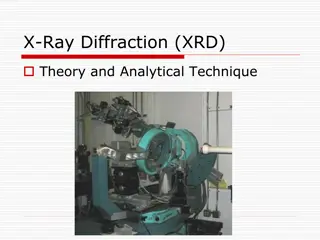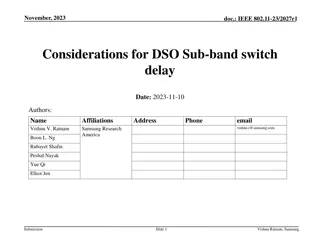Crystallite Size & Band Gap of Tungsten Trioxide Dihydrate Nanocrystals
Tungsten trioxide dihydrate (WO3.2H2O) nanocrystals were prepared under various conditions, showcasing different crystallite sizes and band gaps. The structural properties, applications, and unique features of WO3.2H2O are explored in this study, contributing to the understanding of its potential in diverse fields such as lithium-ion batteries, supercapacitors, gas sensors, photocatalysts, and more.
Uploaded on Feb 18, 2025 | 0 Views
Download Presentation

Please find below an Image/Link to download the presentation.
The content on the website is provided AS IS for your information and personal use only. It may not be sold, licensed, or shared on other websites without obtaining consent from the author.If you encounter any issues during the download, it is possible that the publisher has removed the file from their server.
You are allowed to download the files provided on this website for personal or commercial use, subject to the condition that they are used lawfully. All files are the property of their respective owners.
The content on the website is provided AS IS for your information and personal use only. It may not be sold, licensed, or shared on other websites without obtaining consent from the author.
E N D
Presentation Transcript
Presentation Title Crystallite size and band gap variation of tungsten trioxide dihydrate nanocrystals prepared under different conditions Presented by Sijoy Chandra Boro Research scholar Gauhati University Supervisor Dr. Manas Pratim Chakrapani Kalita Associate Professor, Department of Physics Gauhati University Guwahati-781014 XII th Biennial National Conference of Physics Academy of North East (PANE2021) 2/18/2025 1
ABSTRACT ABSTRACT Tungsten trioxide dihydrate (WO3.2H2O) is a direct band gap n-type semiconductor that has potential applications in various fields. In this work WO3.2H2O, nanocrystals have been prepared using sodium tungstate dihydrate (Na2WO4.2H2O), hydrochloric acid (HCl) and capping agent/oxidizing agent. 2-mercapto ethanol (ME) and hydrogen peroxide (HP) were used as capping agent and oxidizing agent, respectively. X-ray diffraction (XRD) patterns of the as-prepared materials reveal the formation of WO3.2H2O . The average crystallite sizes of the materials prepared using ME and HP have been found to be 53 nm and 21 nm, respectively. The band gaps of the materials have been obtained from the UV-visible absorption studies and the values are found to be 2.62 eV and 2.44 eV for the materials prepared using ME and HP, respectively. Thus, the presented work provides a way to prepare with different crystallite sizes and band gaps. XII th Biennial National Conference of Physics Academy of North East (PANE2021) 2/18/2025 2
Introduction Tungsten trioxide dihydrate is a direct band gap n-type semiconductor that has potential applications in various fields appliction in science. Tungsten oxide hydrates (WO3 nH2O) and tungsten oxides (WO3) have obtained more and more attention due to their polytypic structures and excellent physical/chemical properties. It is a transition-metal-oxide semiconductor with many oxidation states i.e. 2,3,4,5 and 6 and it s band gap ranging between 2.4 eV and 3.3 eV at room temperature[1] Many applications have been extensively investigated such as lithium-ion batteries [4], supercapacitors [5], gas sensors [6], photocatalysts [7, 8], solar energy devices [9], and electrocatalyst in electrolysis of water for HER [10]. Furthermore, the monoclinic WO3 is more stable phase than any other WO3 structures owing to the structure consisting of a three dimensional network of WO6 octahedrons [2] XII th Biennial National Conference of Physics Academy of North East (PANE2021) 2/18/2025 3
Crystalline Structure Crystalline Structure The crystal structure of tungsten oxide dihydrate belongs to the monoclinic P21/n space group. This structural framework consists of a connected network of corner sharing WO6 octahedra and two types of water molecules. The first type, called coordinatedwater , shares its oxygen with the tungsten ion, while the other, referred to as interlayerwater , is located within the (010) plane between the layers of WO6 octahedra. There are four types of oxygen sites in WO3.2H2O: coordinated water oxygen (Oc), bridging oxygen (Ob), terminating oxygen (Ot), and interlayer water oxygen (Oi). Within the distorted octahedra, the relaxed W Ob bond lengths range from 1.86 to 2.03 , and the distance between the W and Ot ions is 1.75 , much shorter than the length of the W Oc bond (2.31 ).[3] XII th Biennial National Conference of Physics Academy of North East (PANE2021) 2/18/2025 4
The variation in WO bond lengths is due to different types of bonding: (1) an Ot ion is only bonded to a W ion, (2) each Ob ion is bonded to two W ions within octahedral planes, and (3) weak W Oc bonding because of strong OC H bonding in the sp3 hybridization [3] Fig. Crystal structure of WO3.2H2O Figure reference Author Hao Lin, Fei Zhou etc.[3] XII th Biennial National Conference of Physics Academy of North East (PANE2021) 2/18/2025 5
XRD XRD XRD pattern matches with the monoclinic WO3.2H2O (JCPDS- 181420) Crystallite size are found to be 21.4 nm and 52.6 nm for 2hTO- 2ME and 2hTO-HP respectively using Scherrer s formula Scherrer s Formula: 94 . = 2 ( L ) cos Fig. plot of XRD for samples 2hTO- 2ME and 2hTO-HP 3 WO 2H O XII th Biennial National Conference of Physics Academy of North East (PANE2021) 2 2/18/2025 6
UV UV- -Visible Visible UV-Visible spectrum of 2hTO-2ME, 2hTO-HP shows maximum absorption at 348 nm and 360 nm respectively. Fig. UV- Visible spectrum of 2hTO-2ME and 2hTO-HP The band gaps have been calculated using the following equation. ) ( c h = 2) ( h E h h 2 ( ) Fig. Tau plot of vs for samples 2hTO-2ME and 2hTO-HP g XII th Biennial National Conference of Physics Academy of North East (PANE2021) 2/18/2025 7
Conclusion: Conclusion: We found that the WO3.2H2O prepared under different conditions using capping agent 2-ME and oxidising agent H2O2 (HP) have different crystallite sizes and band gaps. The average crystallite sizes of the materials prepared using ME and HP have been found to be 53 nm and 21 nm, respectively. The band gaps of the materials have been obtained from the UV-visible absorption studies and the values are found to be 2.62 eV and 2.44 eV for the materials prepared using ME and HP, respectively. Thus, the presented work provides a way to prepare with different crystallite sizes and band gaps. XII th Biennial National Conference of Physics Academy of North East (PANE2021) 2/18/2025 8
References References [1] Wei Li ,Tingting Wang ,Dongdong Huang , Chan Zheng ,Yuekun Lai, Xueqing Xiao , Shuguang Cai and Wenzhe Chen; Hexagonal WO3 0.33H2O Hierarchical Microstructure with Efficient Photocatalytic Degradation Activity. [2] Wen-Hui Hu,1 Guan-Qun Han,1,2 Bin Dong,1,2 and Chen-Guang Liu1, Facile Synthesis of Highly Dispersed WO3 H2O and WO3 Nanoplates for Electrocatalytic Hydrogen Evolution. [3] Hao Lin, Fei Zhou, Chi-Ping Liu and Vidvuds Ozolins, Non-Grotthuss proton diffusion mechanism in tungsten oxide dihydrate from first-principles calculations , J. Mater. Chem. [4] W. Li and Z. Fu, Nanostructured WO3 thin film as a new anode material for lithium-ion batteries, Applied Surface Science. XII th Biennial National Conference of Physics Academy of North East (PANE2021) 2/18/2025 9
[5] M. S. Zhu, W. J. Meng, Y. Huang, Y. Huang, and C. Y. Zhi, Proton- insertion-enhanced pseudocapacitance based on the assembly structure of tungsten oxide, ACS Applied Materials & Interfaces. [6] C. Zhang, A. Boudiba, P. De Marco, R. Snyders, M.-G. Olivier, and M. Debliquy, Room temperature responses of visible-light illuminated WO3 sensors to NO2 in sub-ppm range, Sensors and Actuators B.. [7] J. Yang, W. Li, J. Li, D. Sun, and Q. Chen, Hydrothermal synthesis and photoelectrochemical properties of vertically aligned tungsten trioxide (hydrate) plate-like arrays fabricated directly on FTO substrates, Journal of Materials Chemistry. [8] S. S. Thind, M. Tian, and A. Chen, Direct growth and photoelectrochemical study of Electrochemistry Communications. WO3 nanostructured materials, XII th Biennial National Conference of Physics Academy of North East (PANE2021) 2/18/2025 10
[9] H. D. Zheng, Y. Tachibana, and K. Kalantar-Zadeh, Dyesensitized solar cells based on WO3, Langmuir. [10] D. J. Ham, A. Phuruangrat, S. Thongtem, and J. S. Lee, Hydrothermal synthesis of monoclinic WO3 nanoplates and nanorods used as an electrocatalyst for hydrogen evolution reactions from water, Chemical Engineering Journal. Acknowledgement I would like to thank Mr. Saurav Sarma and Mrs. Pratima Borah , research scholars of GU for their support. I would like to gratefully acknowledge SAIF, GU; RUSA and department of Physics, GU for providing XRD and UV-visible facilities. Also I would like to thank UGC, India for providing NET-JRF fellowship. XII th Biennial National Conference of Physics Academy of North East (PANE2021) 2/18/2025 11
THANK YOU XII th Biennial National Conference of Physics Academy of North East (PANE2021) 2/18/2025 12
